How to crochet a hat - detailed description. Crochet men's hat: master class for beginners. How to crochet a men's hat
The lesson is based on my daughter Varya’s hat. She is 2 years 3 months old. But, knowing the technique, you can knit this classic hat to any size.
Yarn COCO 100% cotton. In 50g. 240 m. It took about 35 grams of green yarn. And for the flower - a little milk. Hooks No. 2.25 and No. 1.75.

Photos enlarge when clicked, so you can see everything in detail!

Before you start knitting, you need to take measurements from your head:
1.
Head circumference. We draw a measuring tape horizontally above the eyebrows and along the level of the most protruding part of the back of the head. In our case, the head circumference is 48 centimeters.
2.
Depth. If we want a cap in depth to the beginning of the eyebrows, then we draw the tape from the middle of one earlobe to the middle of the other earlobe through the center of the crown. In our case, this measurement is 36 centimeters.
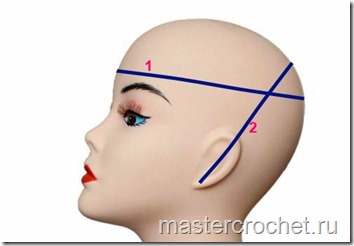
If we need a hat to the middle of the eyebrows, then we measure the depth not from the middle, but from the end of the lobe of one ear through the center of the crown to the end of the lobe of the other ear.
Crochet hats are most often crocheted:
1. From the bottom to the crown. The advantage of this method is that if we take a straight fabric pattern for a hat, it will not be turned “upside down”, but will remain as is, since straight fabric patterns are read from bottom to top, and the hat is knitted from bottom to top. This is where the advantages end. Disadvantages: you need to knit a sample in order to calculate the loops at the beginning of knitting. You can, of course, make a “cunning move”: cast on a chain of chain stitches, wrap it around your head and knit according to this “calculation”, but then the evening will be wasted, because we are unlikely to get the size right. Only a full-fledged sample and calculations based on it! Another disadvantage of knitting from the bottom is that we will not get such a perfect crown, unlike knitting a hat from the top. Although this does not apply to all patterns.
2. From the top of the head - from top to bottom. This method is chosen probably in 90% of cases, primarily because it gives the perfect crown and makes it easy to adjust the size while knitting. I myself crochet hats from the top of the head, and I recommend the same to you.
Today we will knit a hat with double crochets.
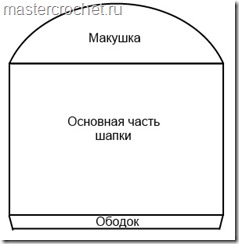
How to knit the crown of a hat?
The crown of the hat is knitted in the round. The main part and the rim are a pipe. There are certain rules for forming a circle.
For a circle of double crochets they are:
Row 1 - knit 12 dc;
2nd row - 24 CCHs: 2 CCHs are knitted into each column of the previous row;
3rd row - 36 Dcs: 2 Dcs are knitted through a post;
4th row - 48 Dcs: 2 Dcs are knitted through two columns;
5th row - 60 Dcs: 2 Dcs are knitted through three columns;
Row 6 - 72 Dcs: 2 Dcs are knitted through four stitches, etc.
Thus, to increase the diameter of the circle, 12 stitches are added evenly in each row by knitting two stitches into one loop in each wedge. There are a total of 12 wedges in this circle of double crochets. Options for distribution of increases:

Choose the method of increase that you like best. I use the second method - I add an increase at the end of each wedge.
If we tie 13 wedges instead of 12, then before moving to the pipe, the circle will look neat:

But, when we move on to knitting the main part, it turns out that the top of the head is folded, which is why it doesn’t look quite neat, and to give the hat a neat look, you’ll have to work hard with an iron and steam:

The diameter of the circle up to which you need to knit the crown is calculated using the formula:
Divide the head circumference by 3.14 (Pi).
48 cm: 3.14 = 15.3 cm. This is also the diameter of the widest part of the hat.
In order for the hat to fit your head beautifully, the transition from the top of the head to the main part of the hat must be made smooth. To do this, subtract 3 -3.5 cm from the calculated diameter of the circle.
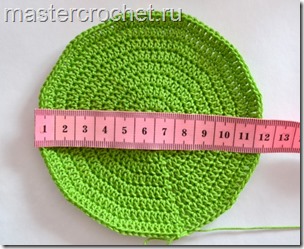
After that, we knit these remaining 3-3.5 cm to the required diameter with increases through a row: a row with increases, a row without increases, a row with increases, a row without increases, a row with increases. As a result, the crown will gradually and neatly round, like a dome.


Some beginners have a problem - noticeable gaps in the places where the row closes.
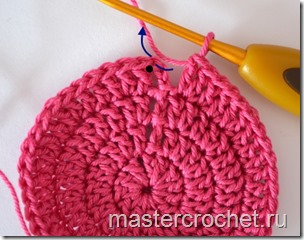
The reason is that when knitting a connecting loop, the hook is inserted between the lifting loops and the post that follows them. In the photo above it is marked with a black circle. The hook must be inserted into the third air loop under the top and middle threads (blue arrow in the photo), and the connecting loop must be knitted tightly. Then there will be no gaps.
Having knitted the top of the head, we move on to the main part of the hat, which we will knit with a pipe.
I think this knitting is an excellent choice, problem solving stitches!
Is there another way to solve the seam problem without resorting to spiral knitting?
There is such a way.
We start the row with two lifting chain stitches and at the same point where the chain stitches are knitted, we knit a double crochet. We knit a row. Tied up. We close it not into the second lifting air loop, as we would have done before, closing the row by knitting a connecting stitch into the top lifting ch, but into the base loop of the next double crochet. In the photo, the place where the hook is inserted when closing a row is shown with a red triangle. This will move the row a little to the left.

Even this method will not give a completely perfect seam, and it will still be a little askew. But after ironing with steam and a little leveling with hands, we get a good result.

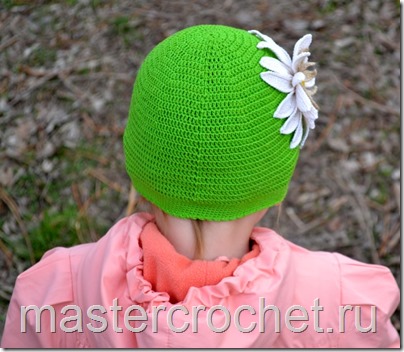
The diameter of the cap should be: head circumference: 3.14 = 15.3 cm.
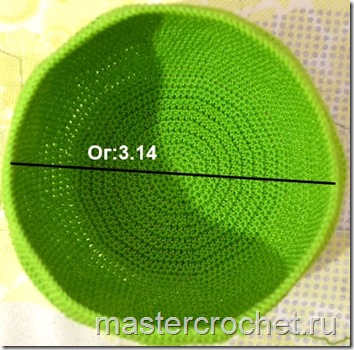
The headband of the hat in our example is tight-fitting, so I took a hook that was full size smaller. Knitted in a spiral with single crochets. We determine the height of the rim as desired: 2-4 cm. The last row was knitted like this: single crochet, 2 chain stitches, skip a loop of a stitch at the bottom, and a single crochet in the loop of the next one. The edge turned out to be in the form of a small picot.
How to determine without trying on whether the depth of the cap is accurate?
To do this, fold the cap in half and measure it from the top of the head to the edge. You should get a number: a measurement from the lobe of one ear to the lobe of the other ear, divided in half. In our case, 36 cm: 2 = 18 cm.
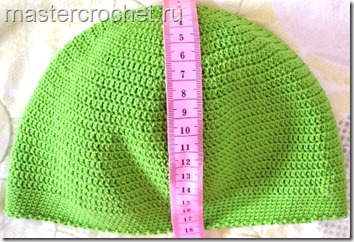
I tried to take model shots. But first, my Varya rushed off somewhere along the windfall.


Then on the site she saw a nest of firefighter beetles. And in general there was no time for photographs. My daughter studied them with such curiosity that I gave up and covered the camera.

I thought about taking pictures at home, but she found the book about chicken more interesting
I didn’t bother to distract.

I tied a flower to the hat: something between a chamomile and a water lily. Daisies give joy, and the water lily is a magical flower.
I knitted it without a pattern, just as the crochet went. And only after sewing the flower to the hat did I remember that I had not written a description for it. Suitable like this:

Adjust the number and height of the petals as desired.
We knit a ring of air loops. A row or two - single crochets. Then the petals, and the last row - we tie all the petals with single crochets.
Such a hat can be decorated with any knitted flowers and entire flower beds, knitted butterflies, and various appliqués. You can knit a hat with multi-colored stripes. Instead of the proposed headband, you can knit a beautiful openwork border...
In short, there are a million options. The main thing is technique, love of knitting and imagination.
I also like these hooked hats because they fit perfectly on the head and do not ride up, unlike many store-bought knitted hats without ties, in which the child turns his head twice and his ears are bare.
The lesson is based on my daughter Varya’s hat. She is 2 years 3 months old. But, knowing the technique, you can knit this classic hat to any size.
Yarn COCO 100% cotton. In 50g. 240 m. It took about 35 grams of green yarn. And for the flower - a little milk. Hooks No. 2.25 and No. 1.75.
Photos enlarge when clicked, so you can see everything in detail!
Before you start knitting, you need to take measurements from your head:
1.
Head circumference. We draw a measuring tape horizontally above the eyebrows and along the level of the most protruding part of the back of the head. In our case, the head circumference is 48 centimeters.
2.
Depth. If we want a cap in depth to the beginning of the eyebrows, then we draw the tape from the middle of one earlobe to the middle of the other earlobe through the center of the crown. In our case, this measurement is 36 centimeters.

If we need a hat to the middle of the eyebrows, then we measure the depth not from the middle, but from the end of the lobe of one ear through the center of the crown to the end of the lobe of the other ear.
Crochet hats are most often crocheted:
1. From the bottom to the crown. The advantage of this method is that if we take a straight fabric pattern for a hat, it will not be turned “upside down”, but will remain as it is, since they are read from bottom to top, and the hat is knitted from bottom to top. This is where the advantages end. Cons: you need to knit a sample to make at the beginning of knitting. You can, of course, make a “cunning move”: cast on a chain of chain stitches, wrap it around your head and knit according to this “calculation”, but then the evening will be wasted, because we are unlikely to get the size right. Only a full-fledged sample and calculations based on it! Another disadvantage of knitting from the bottom is that we will not get such a perfect crown, unlike knitting a hat from the top. Although this does not apply to all patterns.
2. From the top of the head - from top to bottom. This method is chosen probably in 90% of cases, primarily because it gives the perfect crown and makes it easy to adjust the size while knitting. I myself crochet hats from the top of the head, and I recommend the same to you.

How to knit the crown of a hat?
The crown of the hat is knitted in the round. The main part and the rim are . There are certain rules for forming a circle.
For a circle of double crochets they are:
Row 1 – knit 12 dc;
2nd row - 24 CCHs: 2 CCHs are knitted into each column of the previous row;
3rd row - 36 Dcs: 2 Dcs are knitted through a post;
4th row - 48 Dcs: 2 Dcs are knitted through two columns;
5th row - 60 Dcs: 2 Dcs are knitted through three columns;
Row 6 - 72 Dcs: 2 Dcs are knitted through four stitches, etc.
Thus, to increase the diameter of the circle, 12 stitches are added evenly in each row by knitting two stitches into one loop in each wedge. There are a total of 12 wedges in this circle of double crochets. Options for distribution of increases:

Choose the method of increase that you like best. I use the second method - I add an increase at the end of each wedge.
If we tie 13 wedges instead of 12, then before moving to the pipe, the circle will look neat:

But, when we move on to knitting the main part, it turns out that the top of the head is folded, which is why it doesn’t look quite neat, and to give the hat a neat look, you’ll have to work hard with an iron and steam:

The diameter of the circle up to which you need to knit the crown is calculated using the formula:
Divide the head circumference by 3.14 (Pi).
48 cm: 3.14 = 15.3 cm. This is also the diameter of the widest part of the hat.
In order for the hat to fit your head beautifully, the transition from the top of the head to the main part of the hat must be made smooth. To do this, subtract 3–3.5 cm from the calculated diameter of the circle.

After that, we knit these remaining 3-3.5 cm to the required diameter with increases through a row: a row with increases, a row without increases, a row with increases, a row without increases, a row with increases. As a result, the crown will gradually and neatly round, like a dome.
With the help of a hook and thread, in addition to many other different products, you can also make hats of almost any shape and model. It can be a classic women's hat, or a sports hat for men, or a fun, fantasy hat for children. Knitting this headdress will be easy and simple for all crochet lovers if they master some little secrets of creating this product.
The main methods used to create crocheted hats are crocheting from the top of the head, individual wedges or motifs, and also from the bottom of the product. For beginners, it is recommended to crochet a hat from the top of the head, since in this case it is much easier to try on, and the work process is much simpler. When knitting hats from the headband, you need to be very careful and strictly adhere to the pattern and calculations, so as not to ultimately deform the product.
Before creating a hat, it is better to create its pattern, having first taken all measurements: head circumference to calculate the width of the product, length along the line from the beginning of the neck to the forehead, for the depth of the product.
For a loose fit, add a couple of centimeters to the width of the product.
For a simple hat without ears, the headband is crocheted a size smaller than for the rest of the part.
For hats with a length up to the middle of the ear, a total of 2 cm is added, and if the product is planned to be made up to the lobe, then 3 cm.
In order to crochet a hat from the top of your head, you first need to learn how to do it.
If you still choose the method of knitting a hat from the bottom up, then it is better to take a simpler pattern.
Various patterns of crocheted hats
Such a hat can be knitted for small children under one year of age or for those who have just been born, for example, for a discharge kit. For it you need to prepare cotton yarn and a 2.5 hook. The hat is knitted from the top of the head, after which a headband and ears are tied to it according to the following pattern: 
Description of work:
For those who are not very well versed in how, the following table is offered with a visual description of the process of creating a double crochet, relief and half column or connecting column 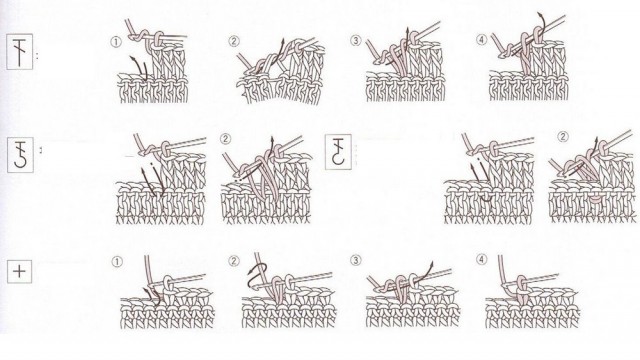
Another example of a children's cap and detailed description its creation is discussed in the following video:
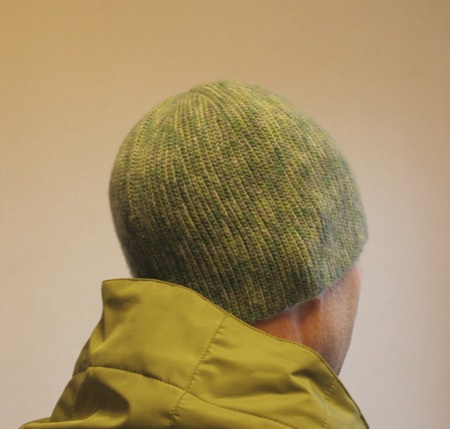 This model is knitted with separate wedges. The advantage of this method is that if the product turns out to be large or, on the contrary, small in volume, then it will be enough to bandage only one or a couple of wedges, rather than redoing the entire cap, but for this the cap is divided into a larger number of sectors.
This model is knitted with separate wedges. The advantage of this method is that if the product turns out to be large or, on the contrary, small in volume, then it will be enough to bandage only one or a couple of wedges, rather than redoing the entire cap, but for this the cap is divided into a larger number of sectors.
The main stages of work are the following:
1.Creating a sample for calculating the height and volume of the product. 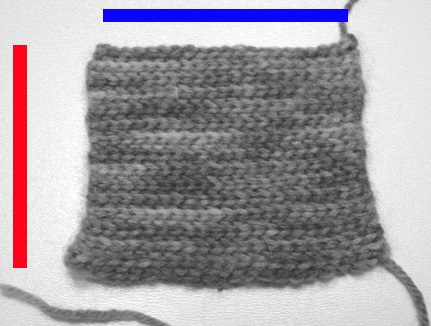
2. We calculate the required number of loops and hems using the formulas:
- Number of loops in a knitted pattern × height of the cap / horizontal length of the pattern = number of loops for the entire fabric.
- The number of scars in the sample × the value of the head circumference / vertical length of the sample = the total number of scars.
3.Then we determine the number of wedges from which we are going to create the product and calculate their width. To do this, divide the total number of loops by the number of wedges.
4. At the next stage, we move on to knitting the parts itself according to the following pattern: 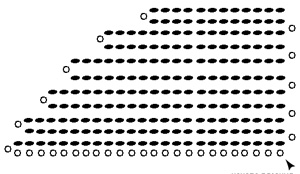

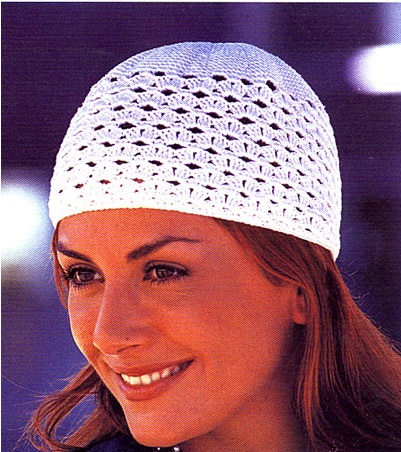 For the summer, as a wonderful addition to your wardrobe and an interesting accessory for girls or little girls, you can knit a hat like this:
For the summer, as a wonderful addition to your wardrobe and an interesting accessory for girls or little girls, you can knit a hat like this:
It is better to knit a hat from thin yarn, such as mercerized cotton. For girls with a head circumference of 53 ± 2 cm, you will need approximately 50 g of this yarn. The product is created from the rim from the bottom up from a combination of a simple pattern from st. non-woven and shell pattern, knitted according to the following pattern: 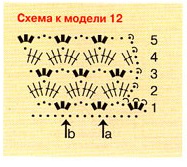
- Repeat 1 (3 treble stitches, 3 ch stitches, skip 3 stitches)
- 2 and all even rows are repeated (3 treble s/n., 1 v. p., 3 treble s/n.) in the arc of the previous row.
- 3 and all odd ones we repeat the pattern: (3 ch, 3 treble s/n) in an arc of 1 st. p. of the previous row.
- Next knit women's hat crochet, you must follow the following steps:
- We knit a ring from 130v. P.
- Next, we knit 1 row of the shell pattern and, starting from the second, repeat the pattern in a circle for 14 rows according to the pattern. Thus, the fabric of the product should rise to a height of 9 cm.
- After this, the pattern changes to a simple one. To do this, in the first row of the transition we knit in single crochets one single crochet, and in an arc of three loops 2 tbsp. b/n. As a result, the next row should have 130 stitches.
- Starting from the next row, we begin to form the crown by making decreases. To do this, in this row we find the 13th loop from the beginning of the row and knit it with the next loop together with st. b/n. After that we make decreases one loop at a time through the row exactly above the decreases of the previous row. We make decreases until there are 10 stitches left in the row. We knit the next row two loops together and get 5 loops, which we carefully collect and pull together using a hook and working thread.
- To prevent the hat from wrapping around the edge, we tie it with single crochets.
It is believed that in the wardrobe of every female representative there should be at least three models of different hats for each season, and children definitely need hats to replace them, so learning how to crochet a hat will not hurt any woman.
This is not cheating. These hats are actually crocheted and not knitted. And this online one was created to introduce you to the technique of knitting such hats.
The first few rows are the hardest, then knitting is easier.
https://img-fotki.yandex.ru/get/6604/124053456.b/0_82837_981...
Be careful.
Insert the hook exactly into the back/far loop of the loop, otherwise the pattern will turn out different, not a 1x1 elastic band.
Periodically count the number of stitches in a row so as not to lose stitches or add extra ones.
Try to knit all the loops and stitches evenly, especially along the edges, so that there are no stretched areas or sagging threads in the fabric.
Watch which way you turn your knitting when moving from row to row, it depends on appearance edges.
Since the connecting column is the lowest in height of all the columns, the increment of the fabric is slower than with regular knitting. In addition, the speed is slowed by the habit of knitting the connecting stitch in two steps. To increase speed, you need to choose the optimal position of your hands and learn how to knit a connecting stitch in one step. About hand placement when crocheting here http://www.stranamam.ru/post/10138457/. You can also find recommendations for left-handed knitters at the link.
Partial knitting
The hats are knitted crosswise in sectors/wedges. The crown is formed according to the principle of partial knitting, i.e. knitting in short rows.
The first method of partial knitting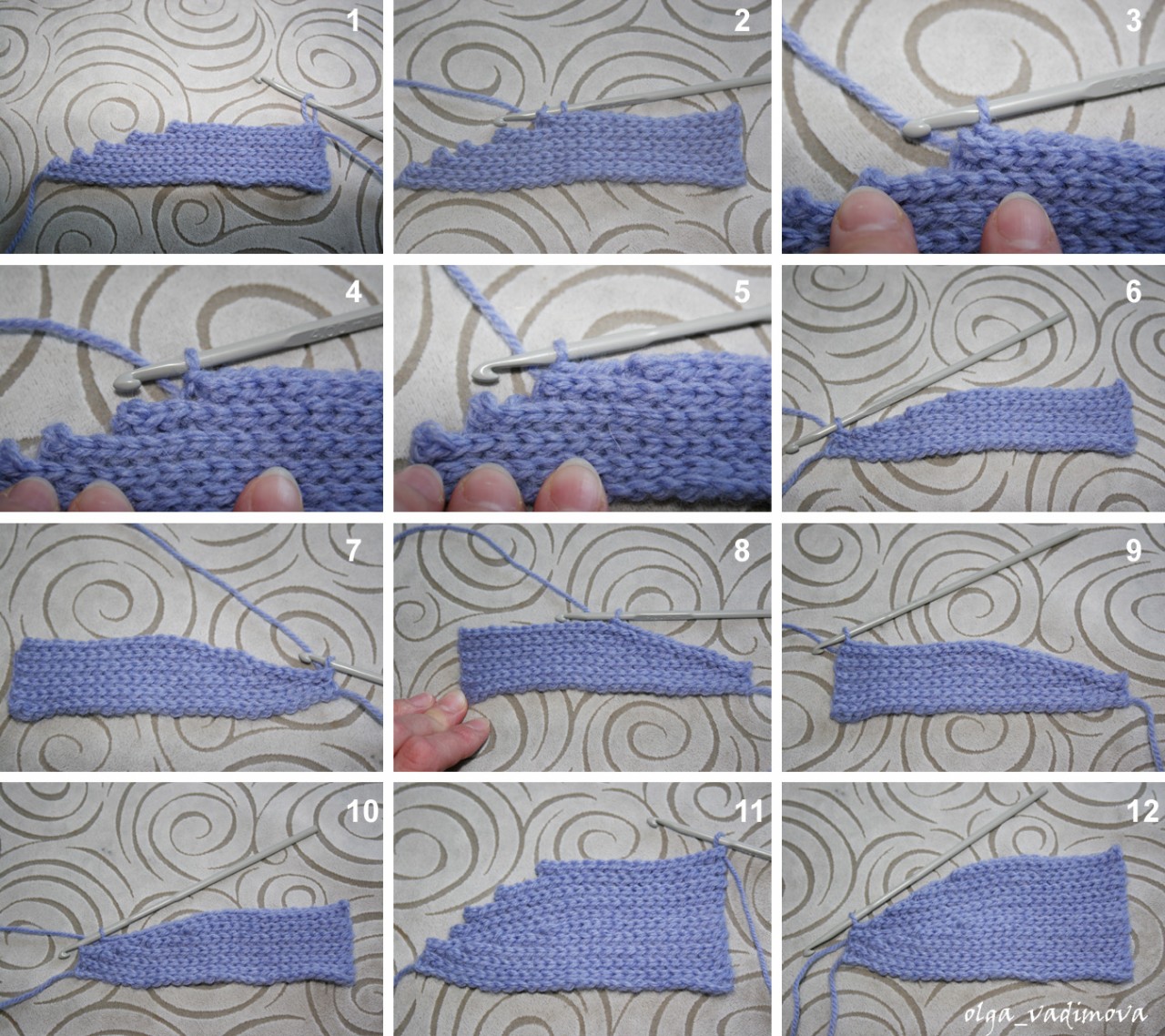
https://img-fotki.yandex.ru/get/6408/124053456.b/0_8351c_edb...
Forming a “ladder” of the first sector and knitting the initial row of the next sector.
1 - the first sector is connected, it turns out to be a “ladder”
2 - start knitting the first row of the next sector
3, 4, 5 - we knit the cloves sequentially, here you need to work extremely carefully to knit the same number of loops as in the first row of the sector
6 - the first row of the second sector is knitted
7, 8, 9 - turn the work and knit the next row of the second sector, then we knit in exactly the same way as we knitted the first sector, according to the same pattern, so that we get exactly the same “ladder”
10 - again we do not knit the row to the end in order to get the first step of the “ladder” of the second sector
11 - all steps of the second sector are knitted
12 - repeating steps 2-6, close the steps of the second sector and get the first row of the third sector
Second method of partial knitting![]()
https://img-fotki.yandex.ru/get/4509/124053456.2a/0_13e816_7...
Recommendations for choosing yarn and selecting a hook.
The yarn is selected depending on the season. For winter and autumn/spring, wool, acrylic or mixed fiber yarn are suitable.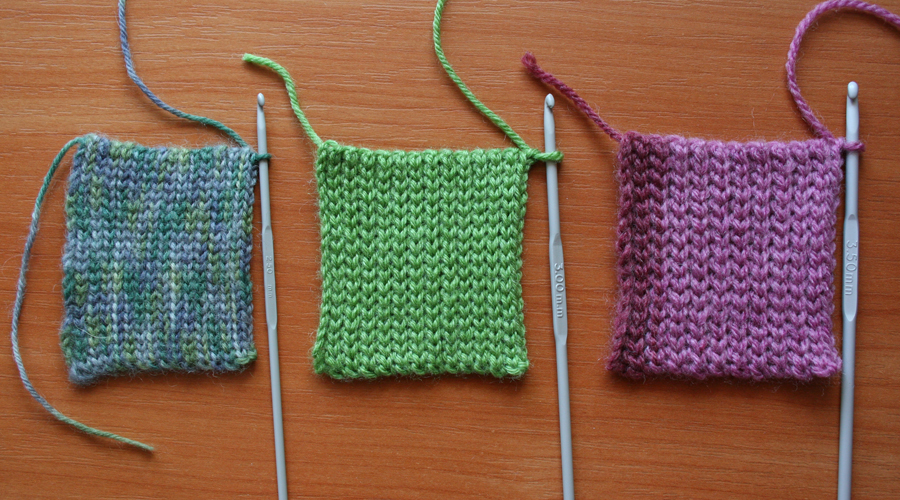
https://img-fotki.yandex.ru/get/6709/124053456.2a/0_13e819_e...
In the photo from left to right
YarnArt Wool (80% wool 30% polyamide, 100g 340m) hook 2.5mm
Alize Baby Wool (40% wool 40% acrylic 20% bamboo, 50g 175m) hook 3mm
YarnArt Crazy Color (35% wool 65% acrylic, 100g 260m) hook 3.5mm

https://img-fotki.yandex.ru/get/4133/124053456.2a/0_13e614_c...
And this is a sample made from double thread Alize Baby Wool Batik Design (40% wool 40% acrylic 20% bamboo, 50g 175m) 4mm hook
Sample and calculation
For the calculation, a head circumference measurement is required. The height of the hat is dictated by the style. For head-fitting hats, you can use the table data when calculating
https://img-fotki.yandex.ru/get/5820/124053456.2a/0_13e826_6...
Table from here http://www.stranamam.ru/post/2350439/
We knit a sample to determine the knitting density. It is advisable to wash it according to the recommendations on the label, then dry it without stretching it. Then, on a slightly stretched sample, we count the number of loops/stitches horizontally and the number of scars vertically (1 scar = 2 rows).
Let's do the calculation. The direction of knitting the hat is along the circumference of the head. For example, horizontally 5cm=17 stitches, which means for a hat height of 22cm the cast-on chain will be 75 stitches, and vertically 5cm=10 stitches, which means 55cm (head circumference) will be 110 stitches. Since the hat is knitted in sectors/wedges, it is necessary to distribute the resulting number of hems among the sectors. I selected the ratio of 11 sectors of 10 rubles = 110 rubles.
Errors in determining the number of sectors.
The number of sectors can be reduced or increased. The more sectors there are, the easier it is to correct the knitting if an error has crept into the preliminary calculations. It will be enough to tie or loosen one or two sectors so that the hat fits the circumference of the head.
https://img-fotki.yandex.ru/get/9748/124053456.2a/0_13e817_4...
Errors in determining the length of the typesetting chain
At first, especially when working with unfamiliar yarn, errors occur in determining the length of the cast-on chain. If the dial chain is short, the height of the hat is insufficient. If the typesetting chain is long, the height, on the contrary, turns out to be excessive. What to do in such cases? If you don’t want to bandage your hat, if the height is not enough, you can tie a strip of the required width at the bottom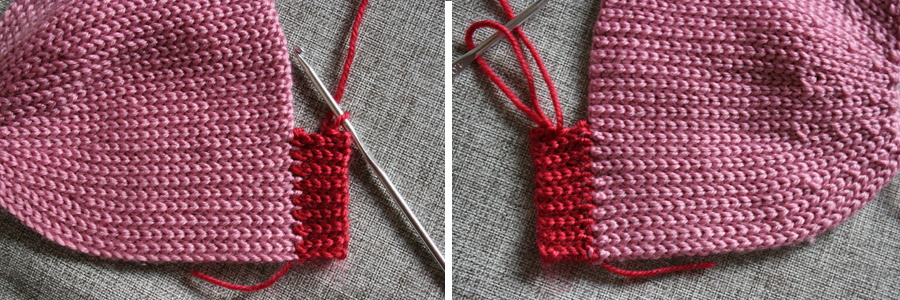
https://img-fotki.yandex.ru/get/6414/124053456.2a/0_13e818_6...
If there is excess height, you can turn the excess outward or turn it inside out. If these options are not suitable, you will have to undo the hat and bandage it.
Making a seam
https://img-fotki.yandex.ru/get/5504/124053456.8/0_632c8_a62...
Just a hat
Suitable for children and adults. Fits well on the head and covers the ears.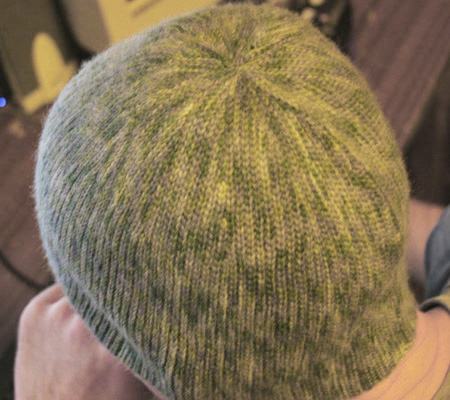
https://img-fotki.yandex.ru/get/6400/124053456.2a/0_13e82d_6...
Hat height is approximately 20-22cm
https://img-fotki.yandex.ru/get/3211/124053456.2a/0_13e81a_1...
Yarn Alize Superwash (75% wool 25% polyamide, 50g 210 m or 100g 420 m) or YarnArt Wool (80% wool 30% polyamide, 100 g 340 m)
Hooks 2.5 or 3mm.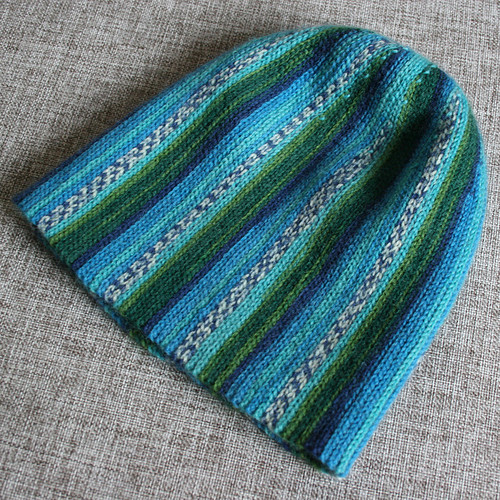
https://img-fotki.yandex.ru/get/4614/124053456.2a/0_13e33f_2...
Video of the process of knitting a hat (no sound, all explanations are included in the credits).
We collect a chain of 75 air. loops + 1 air. lifting loop and knit the “ladder” of the first wedge using partial knitting using the first method according to the algorithm
1 rib – leave 1 loop undone
2-7 scars – leave 2 loops unknitted
8 rib – leave 4 loops undone
9 rib – leave 5 loops unknitted
10 rib – leave 6 loops unknitted
In total, 11 such wedges/sectors need to be connected.
At the end of knitting, carefully pull the loops at the top of the head, sew the edges and tuck the tails into the fabric.
The yarn consumption is about 2/3 of a 100g skein.
https://img-fotki.yandex.ru/get/3110/124053456.2a/0_13e81b_e...
To knit from other yarns, you need to make your own calculations.
Examples of hats
Using the same principle, you can knit a variety of hats.
Classic Stocking Cap design Nancy Nehring
For the lapel it is necessary to increase the number of loops of the cast-on chain. You can choose a different pattern for the lapel.
Rib Stitch Cap design Nancy Nehring
Corkscrew Tassel Cap design Nancy Nehring
Spiral diagram 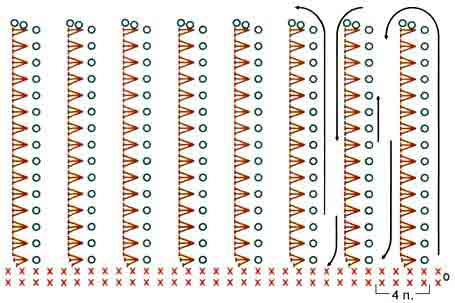
https://img-fotki.yandex.ru/get/4607/124053456.2a/0_13e81d_f...
Hats covering ears
These hats differ from simple ones only in the figured bottom and the presence of ears. The technique of knitting with connecting stitches allows you to create a figured edge.
https://img-fotki.yandex.ru/get/4605/124053456.2a/0_13e81e_5...
Scarves will complement the hats.
"Twisted Pair" is shown here http://www.stranamam.ru/post/9197614/ 
Anyone who knows how to use a crochet hook and knows the simplest stitches with and without crochet will not have any difficulty knitting such a hat. Now I will try to tell you everything in detail step by step. True, don’t judge strictly if I write in some way that is not clear, since this is the first time I’m explaining a knitting pattern in writing. I hope you understand me :)
How to crochet a hat
We start knitting a hat from the top of the head, cast on several loops - a chain, connect it into a circle and then knit it according to this pattern.
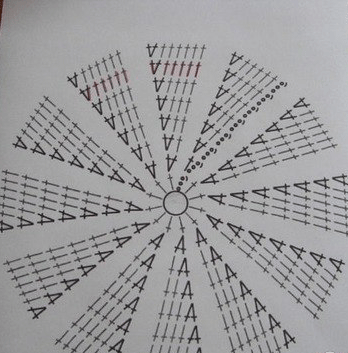

Someone may immediately understand everything from the diagram, but I will try to tell everything step by step.
- We tie the resulting circle with 12 double crochets.
- In the 2nd row we knit 2 columns, in each lower column. We should have 24 stitches... Now we knit not in each lower stitch, but every other stitch, that is, in every 2nd lower stitch we knit 2 double crochets. This makes a total of 36 columns.
- Then in every 3rd column there are 2 double crochets. Now there are 48 columns.
- Then every 4th, every 5th, etc., until our circle evenly increases.
- I knitted about 13 rows.Measure on your head and see for yourself how many rows you need to knit so that the circle covers the top of your head.
- Next, we knit simply evenly without any additions, that is, from each lower column we knit 1 double crochet.
- I knitted about 13 more rows, and you also look at your head.
- Next we knit with a relief elastic band. It is also called convex and concave. This was my first time knitting such an elastic band. I thought it would be difficult. I didn’t understand anything in the diagram, but I watched the video, tried it and everything worked out easily.
Here's a video to help you, those who don't know how can easily learn. There's really nothing difficult here.
I knitted the elastic for about 7 rows. You can start knitting it earlier, but I didn’t make it very wide. I like it better this way.
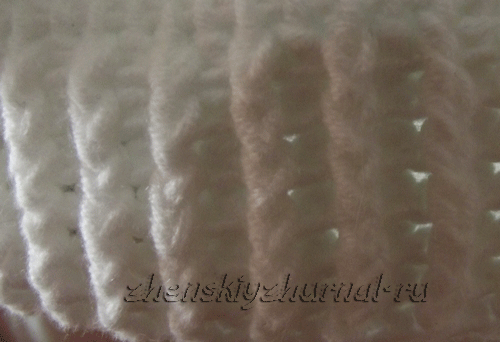
The elastic band is knitted and that’s it, the hat itself is ready. As you can see, crocheting a hat is not at all difficult. All that remains is to crochet the flower. This was difficult for me at first. I tried to figure out this scheme for several days... But I understood little about it. There were hieroglyphs in it that were too incomprehensible for me :)
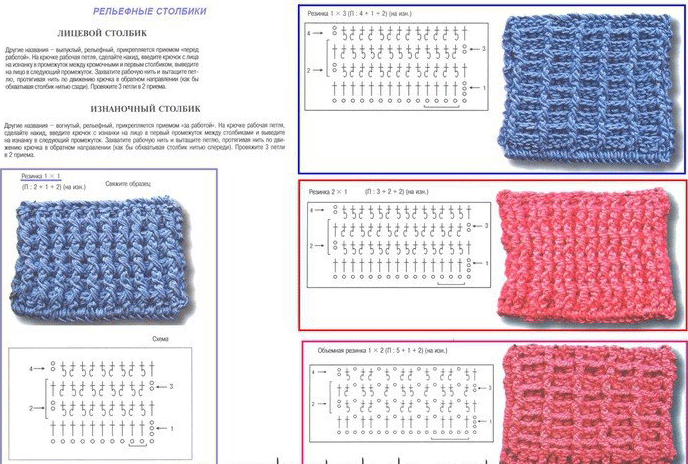
Then I just found step by step instructions and quickly figured it out.
Now I will also try to explain to you step by step how to crochet such a voluminous flower.
We start as usual with a chain, a few loops are enough, 6-8 pieces
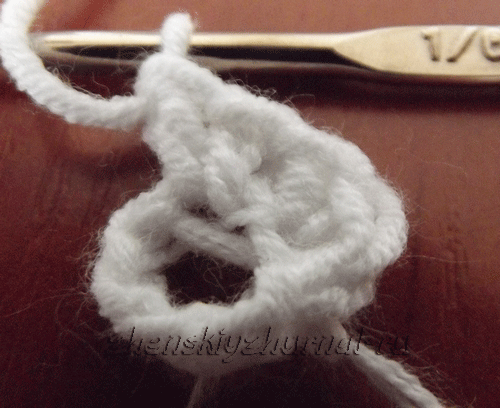
We tie it with 16 single crochets

Then we knit 4 air loops and connect them to every 2nd lower column, that is, through 1 column. We should get 8 petals from air loops. I think it's clear in the photo. This is the first time I'm explaining this in writing. I hope the photos show you this better :)
![]()
We tie all the resulting petals, each with 5 stitches (the outermost 2 stitches are single crochets, and the middle 3 stitches are single crochets.

We knit the petals from the air loops again, only now we need not 4, but 5 air loops, and connect them behind the back wall between the two lower petals
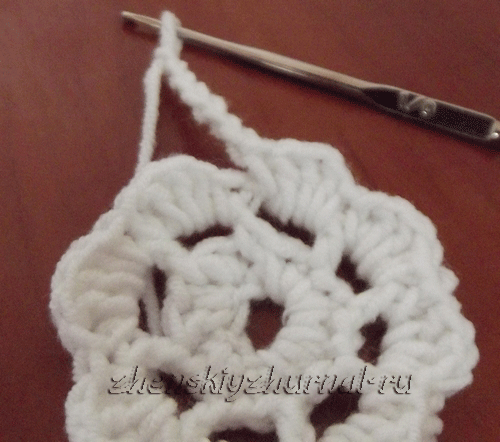
 We tie the resulting petals from air loops, only not with 5 stitches, but with 7 stitches. We knit the outermost stitches without a crochet, then 2 stitches with 1 crochet and in the middle we knit 1 stitch with 2 double crochets. You can carefully look at the diagram attached above.
We tie the resulting petals from air loops, only not with 5 stitches, but with 7 stitches. We knit the outermost stitches without a crochet, then 2 stitches with 1 crochet and in the middle we knit 1 stitch with 2 double crochets. You can carefully look at the diagram attached above.

So gradually with each row we add 1 air loops for the petals, and add columns with which we tie the air loops. We add only the middle loops, which are knitted with 2 yarn overs. For example, at first we had 1 stitch with 2 double crochets, then 3 stitches, then 5, etc. etc. And the extreme ones also remain in 1 single crochet and 2 in single crochet. I think if you look carefully at the diagram, you will understand the principle.
In total I knitted 6 rows of petals. You can do more, or you can do less. Depends on what size flower you want.
I sewed the finished flower onto the hat and decorated the middle with pearl beads. Here's what I got! 🙂 It’s true that the beads in the photo turned out to be somewhat yellow, but in reality they are white.
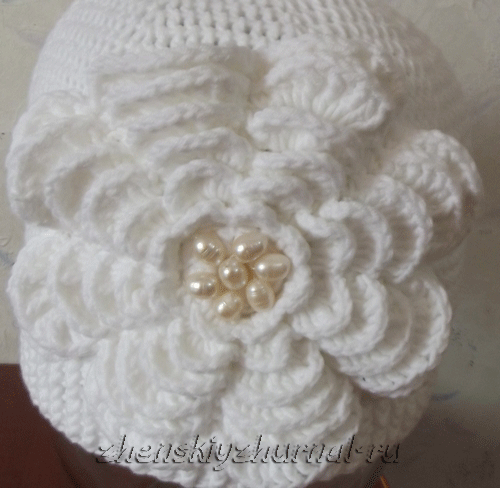
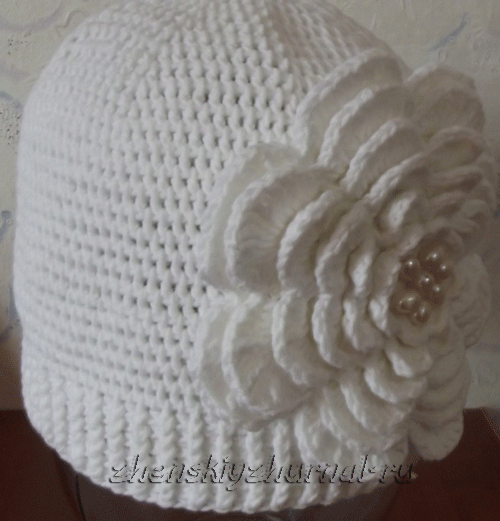
This is how you can quickly and easily crochet a hat! Even a beginner can do it.
All the best!



















